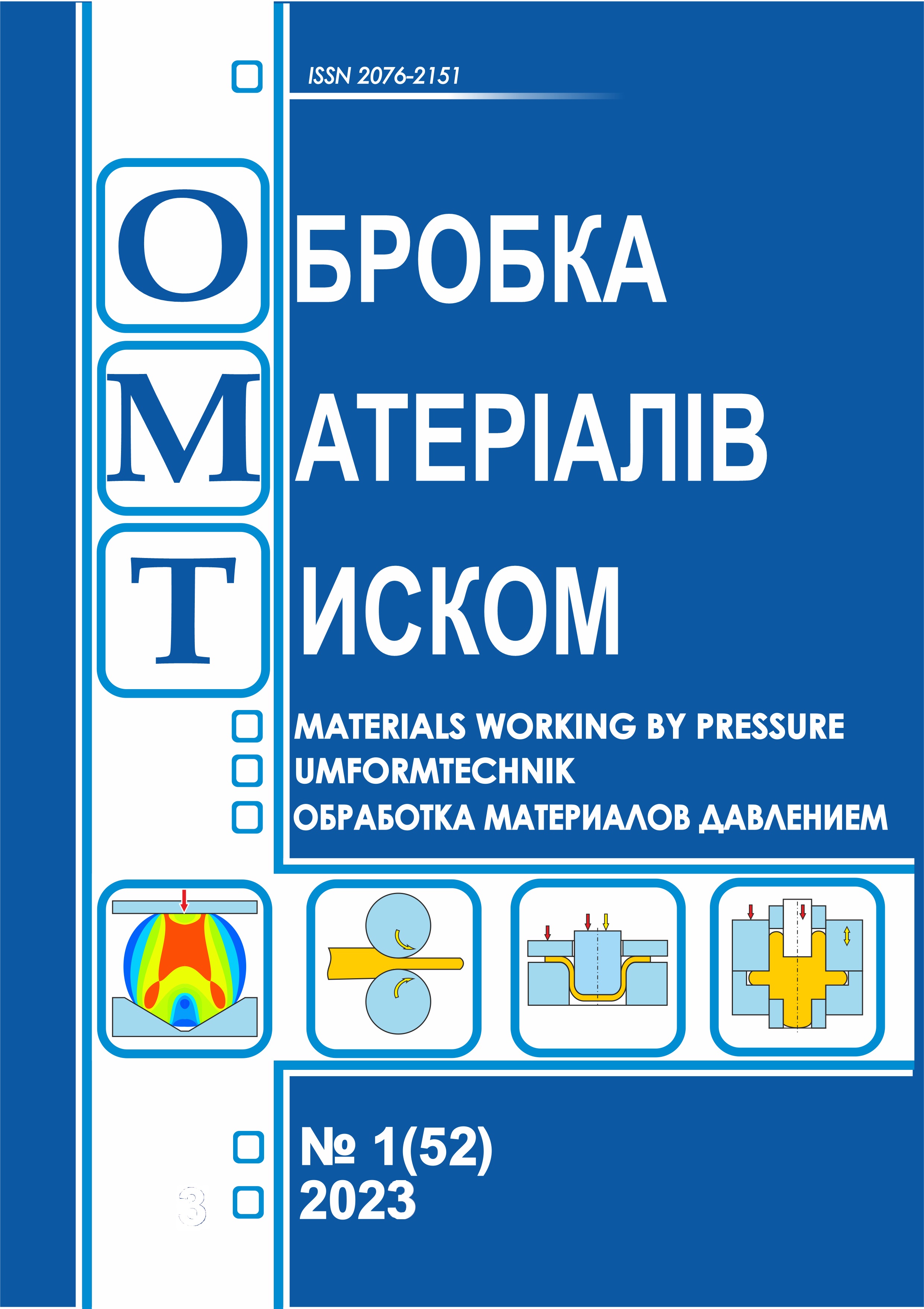Experimental study of a new process of deformation of forgings such as sleeves
DOI:
https://doi.org/10.37142/2076-2151/2023-1(52)79Keywords:
hollow billet, deformation without a mandrel, broach, forging a hole, elongation of a billet.Abstract
Markov. Е., Molodetskyi V., Zinskyi V., Payman А. Experimental study of a new process of deformation of forgings such as sleeves.
A study of a new method for the manufacture of hollow sleeves has been carried out. The proposed method consists in the deformation of a hollow billet with a bottom without a mandrel. A technique for conducting experimental studies based on the law of similarity is proposed. The technique is designed to determine the elongation, forging of the inner diameter and increase in the wall thickness of a hollow billet when deforming hollow forgings with a bottom without using a mandrel. The variable parameters were the hole diameter of the hollow billet, which varied in the range of 0.3 ... 0.8. The hole diameter of the hollow billet was established, which decreases when deformed by the developed method. Regularities were established for the intensity of drawing and the increase in the wall thickness of the hollow billet. A parameter has been proposed to determine the draw ratio of the hollow billet. It was noted that with an increase in the diameter of the hole, the intensity of elongation of the hollow billet increases and the degree of closing of the inner diameter decreases. The defining regularity of the studied deformation schemes is that the value of hollow billet drawing practically does not change depending on the degree of deformation for the same initial geometric parameters of the hollow billet. As a result, an efficient feed was determined which increases the draw ratio of the hollow billet and reduces the forging ratio of the inner cavity. The effective feed should be in the range of 10...15% of the original workpiece diameter. These results were established on samples of lead with the addition of antimony. It has also been found that when the hole diameter of the hollow billet is approximately 0.55 of the billet diameter, there is an intensive increase in the wall thickness of the billet. The error of the obtained experimental results is 7...11%. The established dependences make it possible to determine the final diameter of the hollow blank hole. The results of the study made it possible to establish that the deformation of hollow blanks without a mandrel is possible. The developed new method expands the technological capabilities of the processes for manufacturing sleeve-type forgings.
References
Markov, O., Zlygoriev, V., Gerasimenko, O., Hrudkina, N., Shevtsov, S. (2018). Improving the quality of forgings based on upsetting the workpieces with concave facets. Eastern-European Journal of Enterprise Technologies, 5(1-95), 16-24. http://doi.org/10.15587/1729-4061.2018.142674
Markov, O., Gerasimenko, O., Aliieva, L., Shapoval, A., Kosilov, M. (2019). Development of a new process for expanding stepped tapered rings. Eastern-European Journal of Enterprise Technologies, 2, 16-24. http://doi.org/10.15587/1729-4061.2019.160395
Sanjari, M., Saidi, P., Taheri, A.K., Zadeh, M.H. (2012). Determination of strain field and heterogeneity in radial forging of tube using finite element method and microhardness test. Materials and Design, 38, 147–153.
Wang, Z. G. (2011). The theory analysis and numerical simulation for the radial forging process of gun barrel. Nanjing University of Science and Technology, 28–30.
Knauf, F., Nieschwitz, P.J., Holl, A., Pelster, H., Vest, R. (2011). Latest Development in Railway Axle and ThickWalled Tube forging on a Hydraulic Radial Forging Machine Type SMX. 18th International Forgemasters Meeting. Market and Technical Proceedings. Pittsburgh, USA. September 12–15, 215–220.
Koppensteiner, R., Tang, Z. (2011). Optimizing Tooling And Pass Design For Effectiveness On Forged Product. 18th International Forgemasters Meeting. Market and Technical Proceedings. Pittsburgh, USA. September 12–15, 225–229.
Sheu, J.J., Lin, S.Y., Hsien, C.Y. (2014). Optimum die design for single pass steel tube drawing with large strain deformation. 11th International Conference on Technology of Plasticity, 19-24 October. Nagoya, Japan. Procedia Engineering, 81, 688–693.
Jaouen, О., Costes, F., Lasne, P., Barbelet, M. (2011). From Hollow Ingot to Shell with a Powerful Numerical Simulation Software Tool. 18th International Forgemasters Meeting. Market and Technical Proceedings. Pittsburgh, USA. – September 12–15, 513–518.
Li ,Y., He, T., Zeng, Z. (2013). Numerical simulation and experimental study on the tube sinking of a thinwalled copper tube with axially inner micro grooves by radial forging. Journal of Materials Processing Technology, 213, 987–996.
Li, Y., Huang, J., Huang, G., Wang, W., Chen, J., Zeng, Z. (2014). Comparison of radial forging between the two and threesplit dies of a thinwalled copper tube during tube sinking. Materials and Design, 56, 822–832.
Markov, O.E., Oleshko, M.V., Mishina, V.I. (2011). Development of Energy-saving Technological Process of Shafts Forging Weighting More Than 100 Tons without Ingot Upsetting. Metalurgical and Mining Industry, 3(7), 87–90. http://www.metaljournal.com.ua/assets/Uploads/attachments/87Markov.pdf
Markov, O.E., Perig, A.V., Markova, M.A., Zlygoriev, V.N. (2016). Development of a new process for forging plates using intensive plastic deformation. Int J Adv Manuf Technol., 83(9-12), 2159–2174. http://doi.org/10.1007/s00170-015-8217-5
Kukhar, V., Burko, V., Prysiazhnyi, A., Balalayeva, E., Nahnibeda M. (2016). Development of alternative technology of dual forming of profiled workpiece obtained by buckling. East-European Journal of Enterprise Technology, 3/7(81), 53–61. https://doi:10.15587/1729-4061.2016.72063
Markov, O.E. (2012). Forging of Large Pieces by Tapered Faces. Steel in Translation, 42 (12), 808 – 810. https://doi.org/10.3103/S0967091212120054
Zhbankov, I.G., Markov, O.E., Perig, A.V. (2014). Rational Parameters of Profiled Workpieces for an Upsetting Process. International Journal Advanced Manufacturing Technology, 72, 865–872. https://doi.org/10.1007/s00170-014-5727-5
Markov, O.E., Perig, A.V., Zlygoriev, V.N., Markova, M.A., Grin, A.G. (2017). А new process for forging shafts with convex dies. Research into the stressed state. International Journal Advanced Manufacturing Technology, 90, 801 – 818. http://doi.org/10.1007/s00170-016-9378-6

